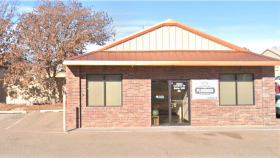Expert Insights
Amarillo has seen a major spike in the number of fentanyl addictions over the last 6 months. The truth is that fentanyl is easy to find and it’s very cheap. Experts believe that’s why they are seeing such an increase in the number of people addicted. But fentanyl is also one of the most difficult drugs to detox from, making things even more difficult. However, local Amarillo treatment centers are now beginning to use medication assisted treatment in order to combat fentanyl addiction, and they’re seeing good results with 40 to 60% of participants going on to live lives in recovery. The medication assisted treatment programs include a combination of psychosocial therapy and a drug known as Suboxone. If we are going to combat the fFentanyl epidemic, we certainly need all hands on deck. And once again, it looks like Suboxone has become one of the number one tools in the arsenal. I hope to see more treatment centers embrace this method if it is, in fact, as successful as the trials seem to indicate in Amarillo.
~ Natalie Baker
Cost of Drug Rehab in Amarillo
The cost of rehab depends on multiple variables, such as where you decide to go and what type of amenities you expect to enjoy. For example, if you’re looking forward to massage therapy and a fitness center with a spa, then you can probably expect to pay more for that specific facility.
Generally, people use their health insurance to pay for care, but many people don’t have insurance. To pay for treatment, it might be necessary to ask for help. You can take out a medical loan if you have a good credit score, or you can ask friends or family for money to fund your rehab. You can also look to crowdfunding websites to ask anonymous donors online for assistance.
Low-Cost and Drug Free Rehab Centers in Amarillo
 If you are low-income and underinsured, there are drug rehabs in Amarillo that provide low-cost services and offer alternative financing options. A common method of allowing access to care for low-income Texans is by offering sliding-scale fee services. These are services that are offered at a discount, with their cost depending on your income, instead of a flat fee. Another low-cost option is a scholarship, which could pay for some or all of your treatment costs. This option is only for people with no other way to pay for care.
If you are low-income and underinsured, there are drug rehabs in Amarillo that provide low-cost services and offer alternative financing options. A common method of allowing access to care for low-income Texans is by offering sliding-scale fee services. These are services that are offered at a discount, with their cost depending on your income, instead of a flat fee. Another low-cost option is a scholarship, which could pay for some or all of your treatment costs. This option is only for people with no other way to pay for care.
Depending on the level of care you need, many services are offered for free or low-cost services throughout Amarillo that can help fill gaps in care. For example, drug counseling, education, and support groups can be found completely free from social services agencies and non-profit organizations. The best way to find these types of services is to call 211, the statewide social services hotline.
Do Medicare and Medicaid Cover Rehab Center Costs?
Yes, though not all services provided at an inpatient facility may be covered. Both programs cover the cost of medically-necessary treatments such as medication, medical supervision, and therapy. Medicare can pay for the cost of residential stays in a facility, but there is a daily co-pay and other fees that you may be responsible for.
Medicaid doesn’t pay for residential care, though it may cover the cost of hospitalization for detox purposes. Outpatient programs exist to help people who can’t utilize inpatient rehab, either due to life circumstances or a lack of funding, providing similar levels of care without offering a place to stay or daily meals.
Does Private Insurance Cover Addiction Treatment?
Yes, private health insurance companies must pay for treatment for medical disorders, including substance use disorder (SUD). This is widely due to the reclassification of substance abuse as a diagnosable medical disorder and legislation like the Affordable Care Act.
Every health insurance plan has different policies, in-network providers, co-pays, deductibles, and other fees and rules. To find out exactly what your health insurance covers, call the number on the back of the card. They’ll be able to explain your plan details, including your costs, and refer you to a local in-network provider.
Amarillo, TX Drug and Alcohol Use Statistics
Amarillo is a city in Texas seated in Potter county. According to data from the CDC:1

While the rate of alcohol-induced deaths dropped from 2018 to 2019 by 24.79%, it rocketed up the next year by 63.25%

Drug overdose deaths rose 34% in the county between 2018 and 2020

The county has an 89% higher rate of drug overdoses than the rest of Texas as of 2020

The opioid dispensing rate for Potter County, where Amarillo is located, was 102.8 per 100 residents in 2020.
Drug and Alcohol Laws in Amarillo, TX
Texas has enacted numerous laws to help protect citizens from the danger of substance use, helping provide access to life-saving medication as well as enabling people to seek rehab.
Federal Family and Medical Leave Act (FMLA): The federal FMLA laws apply to every company in the US, as long as they have over 50 employees and qualify under other rules such as having enough employees within a certain radius of the work site.5 FMLA requires most employers to offer their employees at least 12 weeks of unpaid leave to seek medical treatment or care for a family member. Employers are prohibited from discriminating against a medical condition such as substance use disorder (SUD) and must provide the same or a similar position with equal or better pay when the employee returns.
Good Samaritan Overdose Law: The Good Samaritan Overdose law helps protect people from prosecution if they call emergency services to help with an overdose.6 This could mean preventing jail time if you have drugs or paraphernalia, but you call 911 to help save the life of someone overdosing on opiates or other drugs. The law also protects first responders and civilians from being sued for using overdose reversal medication, Naloxone, without prior consent or authorization.
SB 1462 Naloxone Law: This law was enacted to allow open access to the overdose reversal drug Naloxone and to encourage citizens to help prevent overdose deaths.7 It allows prescribers to provide Naloxone prescriptions to emergency personnel, family members of people that use opiate medications or illicit drugs, and people who are in a position to assist someone experiencing an overdose.
Call us at
800-681-1058
(Who Answers?)
if you’re struggling with addiction. We are available 24/7 to answer your questions, find accredited alcohol and drug rehab centers in Amarillo for you to attend, and verify your insurance coverage.
Addiction Treatment Settings
The rehabilitation process begins with a thorough examination of your background, medical history, and substance use throughout the years leading up to your current addiction. This is called a substance use assessment and is used to guide the course of treatment throughout your time in care. You’ll then enter into a program that makes sense for you, depending on your needs and ability.
The continuum of care for addiction and recovery has several levels, with you moving through each level over time as you need less supervision and intensive therapy. You can start with inpatient care, where you live in the care facility, and move down to standard outpatient programs (SOPs), where you only visit a treatment center for therapy once a week and can do so by phone if you choose. Each step is set up to build upon the skills learned in the previous level of care, as well as your increasing resilience to cravings and temptation.
Medical Detox
Certain addictions cause harsher physical withdrawal symptoms than others, namely alcohol use disorder (AUD) and opiate use disorder (OUD). The process of detoxing your body from these substances causes a cascade of symptoms that range from mild to life-threatening.
As a result, it’s necessary to have medical supervision during this recovery period and access to stabilizing medications such as IV fluids to combat dehydration.
Inpatient Drug Rehab in Amarillo, TX
Inpatient rehab is a type of addiction therapy that provides a structured environment for you to live in, from thirty days to several months, depending on your needs and preferences. These facilities provide a comfortable place to sleep and keep your things, three meals a day, and scheduled therapy and other therapeutic activities throughout the day.
The benefits of inpatient care include a better chance of a full recovery. These programs are dedicated to helping you overcome cravings and learn life skills in an intensive, daily manner, so you can get past the initial stages of rehab without relapsing.
Step-Down Care
Once you’ve graduated from inpatient, it’s important to continue utilizing services by stepping down into a lower level of care. This can help encourage you to remain steadfast in your sobriety, as well as continue to work on the skills that you learned in rehab to cope with life stresses. There are several levels on the continuum of care, only starting with residential inpatient care.
The first level of care after residential care is a partial hospitalization program or PHP. This type of program involves visiting a treatment center every day, or every weekday, to have medication administered and to participate in drug counseling and ongoing therapy. If you aren’t able to utilize inpatient due to life circumstances, then you could try entry in a PHP instead of going to inpatient, as long as you have a strong support system at home. Some PHP centers allow for medical detox without requiring hospitalization, as well.
Intensive outpatient programs (IOPs) are the next lower level of care, requiring a minimum of nine hours per week in therapy, whether in the clinic or using telehealth services.3 Patients of IOPs must also have routine phone calls with their therapy team, usually monthly. The lowest level of care, standard outpatient programs (SOPs), require a single meeting a week and usually ask clients to also participate in community support such as NA/AA or SMART Recovery groups.
Aftercare and Relapse Prevention
Once you’ve graduated from the lowest level of care you choose to participate in, you’ll need aftercare services in place to ensure your lasting recovery. A quality drug rehab in Amarillo will help you set up an aftercare and relapse prevention plan well before you leave the center, with specific steps and check-in times. Many addiction treatment centers provide Alumni programs to graduates with support groups and regular reunions.
There are different programs you can take part in once you leave care, aside from your center’s Alumni program. Aftercare options need to take into account your preferences, such as if you appreciate using spirituality in your therapy sessions or not. Community support groups AA and NA follow a 12-step recovery process, relying heavily on your connection with a higher power along each step of the way. If this doesn’t appeal to you, then look for a SMART Recovery program that focuses more on evidence-based therapies than any faith-based philosophy of care.
If you need help finding aftercare or have relapsed, call us at
800-681-1058
(Who Answers?)
to get back on track.
What to Look for in a Quality Treatment Program
There are multiple aspects to consider when trying to determine if a program is high-quality or not. For example, do they have a large enough staff of certified professionals to facilitate a small patient-to-counselor ratio? This is important because you want to make sure that you have enough one-on-one time with a counselor to facilitate your treatment success.
Here are some other factors to consider:
Aftercare and Alumni Programs
Quality facilities and detox centers in Amarillo recognize that addiction recovery is a lifelong process and have programs in place to help clients throughout every stage. Many facilities have Alumni programs, with monthly support groups for graduates of their program, and regular social events. Rehabs can also have aftercare programs, which work similarly.
Licensed Practitioners and Program Accreditation
Some services, such as medication-assisted treatment (MAT), require federal certification to be held by providers. Other therapies, such as alternative therapies like art therapy, might not require any licensing, but the practitioner can hold a range of degrees and licenses to enhance their ability to facilitate healing.
Access to Medical Care
A great treatment center will have the medical supplies and experienced staff available to handle any medical emergency residents might face. This is especially important if you’re facing a severe addiction with dangerous withdrawal symptoms, are pregnant, or have an underlying health condition.
Financing Options
Many high-qualitydrug and alcohol rehab centers in Amarillo will have some type of payment assistance, whether it’s a way to help you borrow money to pay back later or over some time in payment plans or by offering a sliding-fee scale so people with lower incomes can afford treatment there.
Should You Travel for Drug and Alcohol Rehab in Amarillo?
 If you love the south, with its mild winters and long summers, then visiting Amarillo for rehab could be a good idea. Being the second-largest state in the country, Texas has a wealth of areas to move from the beach to the country.
If you love the south, with its mild winters and long summers, then visiting Amarillo for rehab could be a good idea. Being the second-largest state in the country, Texas has a wealth of areas to move from the beach to the country.
When looking to move for rehab, make sure that you can pay for treatment in the area by verifying your coverage with your insurance provider or looking into available low-cost programs if you’re underinsured. It’s also a good idea to make sure you have a support system in place anywhere you choose to move for rehab, such as friends or family that live in the area.
Amarillo is a beautiful town in the northern part of the Texas panhandle. The city has plenty of fun activities to enjoy with friends and family, such as the Amarillo Botanical Gardens on the west side, and the Wonderland Amusement Park on the north.
The Rick Husband Amarillo International Airport is on the far east side of Amarillo and is near several interesting attractions. This area has the Amarillo Railroad Museum, the Aztec Music Hall, and several camping parks.
Southcentral Amarillo has the Tradewind Airport and plenty of shopping, as well as venues for car enthusiasts. The Route 66 Motor Speedway is near this part of town, as well as Bill’s Backyard Classics car museum.
The west portion of the town has the most access to substance use treatment centers, with five of the six facilities in Amarillo being in this area.4 The other is downtown, which is home to Thompson Memorial Park and a wealth of dining and short-term housing options.
Resources
- FindTreatment.gov. (n.d.). FindTreatment.gov.
- Center for Disease Control. (2022). CDC Wonder.
- National Library of Medicine, Medline Plus. (2022). Alcohol Withdrawal.
- Center for Substance Abuse Treatment. Substance Abuse: Clinical Issues in Intensive Outpatient Treatment. Rockville (MD): Substance Abuse and Mental Health Services Administration (US); (2006). Chapter 3. Intensive Outpatient Treatment and the Continuum of Care.
- Substance Abuse and Mental Health Services Administration. (2022). SAMHSA Behavioral Health Treatment Services Locator.
- U.S. Department of Labor. (2022). Family and Medical Leave Act.
- Texas Department of Health Services. (2018). Overview of Drug Overdose Good Samaritan Laws.
- State of Texas Legislature. (April 22, 2015). SB 1462
















